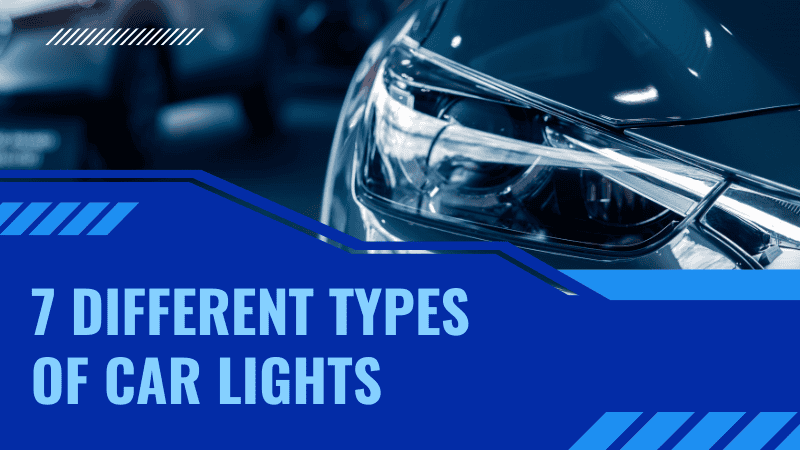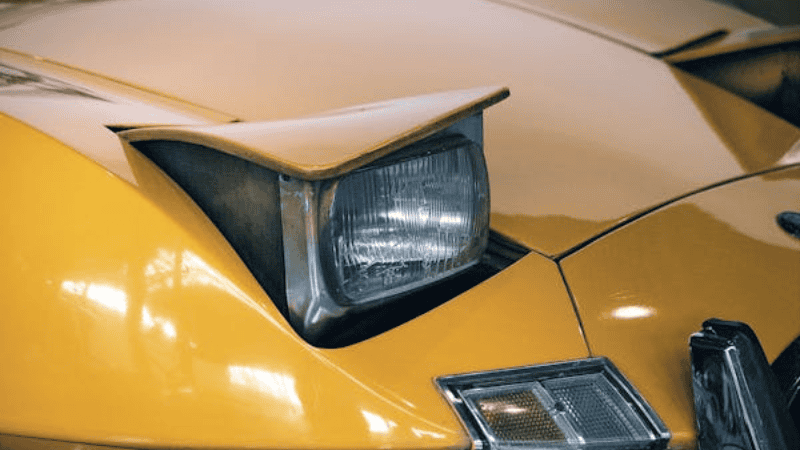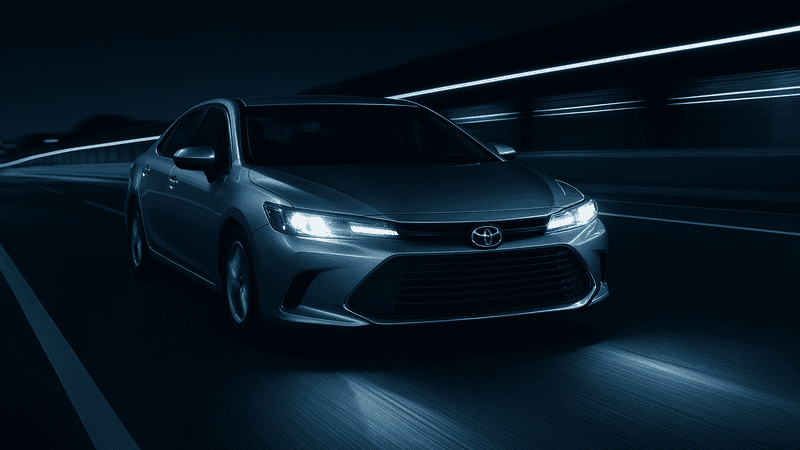Among the common types of car lights are headlights, fog lights, brake lights, hazard lights, and turn signals. But what if we told you that there are more types of car lights that you may not have heard of before?
Each type serves a specific purpose and can come in handy in different situations. Whether you are a new driver or an experienced one, we bet you’ll not be familiar with all the types of car lights that we will share today.
So, without further ado, let’s explore the different types of car lights, when to use them, and some laws regarding car lights. Also, we will share some common mistakes that drivers usually make with their car lights and how to avoid them.
1. Headlights
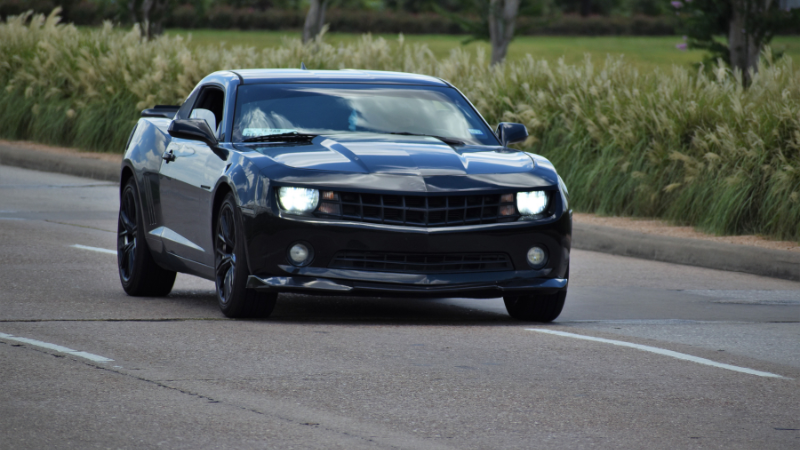
Headlights are the eyes of your car, illuminating the road ahead during nighttime or in any low-visibility conditions like fog or heavy rain. Headlights are further divided into four types: Halogen, HID, LED, and Laser.
Halogen headlights are the most common type and emit a yellowish light. HID (High-Intensity Discharge) headlights produce a bluish-white light and can be found in luxury cars.
LED (Light Emitting Diode) headlights have become popular due to their energy efficiency and bright white light. They are one of the brightest lights out there.
Lastly, Laser headlights are currently only available in select BMW models and provide the longest visibility range.
In terms of working, headlights come in two main settings: low beam and high beam. Low-beam headlights cast light down onto the road and are designed to minimize glare for oncoming drivers, making them the default choice for most driving situations.
High beam headlights, on the other hand, offer a brighter and longer range of visibility but should be used sparingly, only when there are no oncoming vehicles, to avoid blinding other drivers.
2. Daytime Running Lights
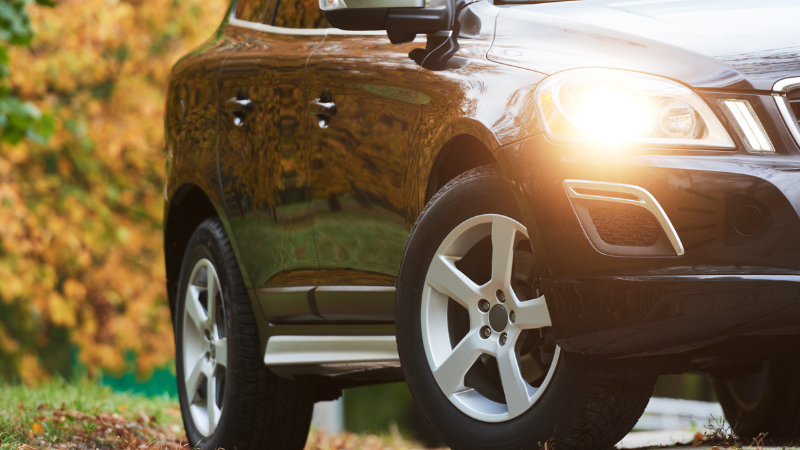
Daytime Running Lights, or DRLs, are designed to make vehicles more visible to other drivers and pedestrians during the daytime.
Unlike headlights, which are used in low-visibility conditions to light up the road ahead, DRLs automatically switch on when the vehicle is in motion, emitting a soft light from the front of the car.
These lights are not meant to help the driver see the road but to enhance the car’s visibility, reducing the risk of accidents in daylight. A study found that DRLs reduced opposite-direction/angle daytime non-fatal crashes by 5 percent.
You should use DRLs during the daytime, especially on cloudy or rainy days when natural light conditions are reduced.
An interesting fact about DRLs is that in some countries, their use during daytime is mandated by law, recognizing their importance in improving road safety.
3. Fog Lights

Fog lights are designed to cut through dense fog, snow, or heavy rain and light up the road ahead for increased visibility. These lights produce a low, wide beam that is aimed towards the ground instead of directly in front like regular headlights.
This helps minimize glare from reflecting off the fog and improves visibility for the driver. Fog lights, both rear fog lights and front fog lights, are very useful in rural areas with no streetlights or on winding roads with limited visibility.
Fog lights come in different colors, particularly yellow, white, and blue. While yellow fog lights are the most common, some drivers opt for white or blue fog lights as they believe they give their vehicle a more modern and stylish look.
However, you have to understand that different colors have different levels of brightness and can affect your visibility in foggy conditions. So, it is always best to stick to the color that performs best in the driving conditions you face every day.
If you are confused between yellow and white fog lights, make sure to check our Yellow vs. White Fog Lights. This comparison will help you choose the right fog lights for your car, depending on your driving needs.
4. Tail Lights and Brake Lights
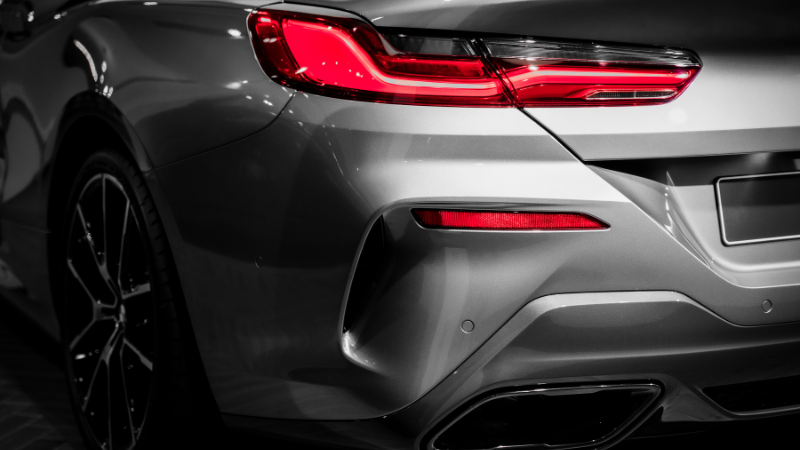
Tail lights and brake lights serve two distinct, yet equally important roles in ensuring safety and communication between drivers on the road.
Tail lights, which emit a steady red light, are activated when the vehicle’s headlights are turned on or when the parking lights are engaged.
The primary purpose of these rear lights is to indicate the presence and position of your vehicle to others on the road. This helps prevent rear-end collisions and allows drivers behind you to maintain a safe distance.
Brake lights, on the other hand, are designed to alert other drivers when they are decelerating or stopping. These lights are more luminous than the tail lights and are activated instantly when pressure is applied to the vehicle’s brake pedal.
The difference in brightness ensures a clear and immediate warning to other road users that your vehicle is slowing down or coming to a stop, providing them with sufficient time to adjust their speed accordingly.
Many modern cars have also been equipped with a third brake light, often called the “center high mount stop lamp.” This light is mounted at the center of the rear windshield, providing an additional warning to drivers behind.
5. Signal Lights (Turn Indicators)
Signal lights, more commonly referred to as turn indicators or indicator lights, play a crucial role in ensuring road traffic safety and smooth flow.
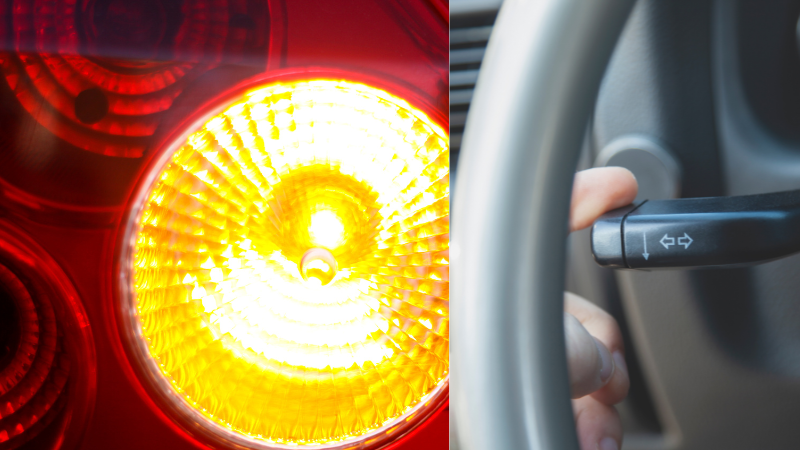
They are essential tools for communicating a driver’s intentions to make turns, change lanes, enter driveways or parking lots, park alongside the street, pull over, or pass other vehicles.
They can convey these actions to other road users, preventing confusion and significantly reducing the chances of accidents.
For example, when a driver intends to turn the steering wheel left or right at an intersection, entering a driveway, or parking on the side of the street, using the signal lights gives nearby drivers and pedestrians advance notice of these movements.
This warning is vital, especially in busy traffic conditions, as it allows others to adjust their path or speed accordingly.
Similarly, when changing lanes or passing another vehicle on the road, activating the appropriate signal light informs other drivers of your move, making the process safer for everyone involved.
Legal requirements reinforce the importance of using signal lights. A prime example is Vehicle Code § 22108 VC in California, which mandates motorists to signal their intention to turn right or left continuously during the last 100 feet traveled by the vehicle before turning.
This law shows how important it is to give clear and early signals before turning or changing lanes. It sets rules that stress how crucial signal lights are for keeping roads safe.
6. Hazard Lights
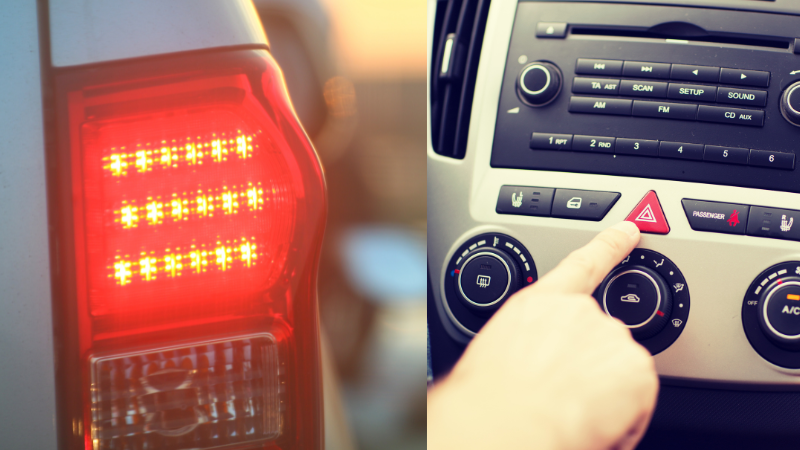
Hazard warning lights, also known as warning flashers, indicate that a vehicle is experiencing an emergency or is temporarily stationary in hazardous situations. There are several cases when you need to use hazard lights, such as:
- Your car breaks down: If your vehicle experiences trouble and you need to pull over, switch on your hazard lights as soon as you reach a safe spot. This warns oncoming traffic of your situation, allowing them to give you space or slow down as they pass.
- You are changing a tire: If you need to change a tire on the roadside, make sure to turn on your hazard lights. This is very important during times of low visibility, such as at night or in foggy conditions, to ensure other oncoming cars can see your car and proceed cautiously.
- You get into a car accident: Using your hazard lights alerts other drivers about the accident, helping to prevent further incidents and ensuring that help can be directed to your location more efficiently.
- You are getting pulled over by a police officer: If a police officer signals you to pull over, turn on your hazard lights to inform other drivers about the situation. This can help prevent accidents and ensure the safety of everyone involved.
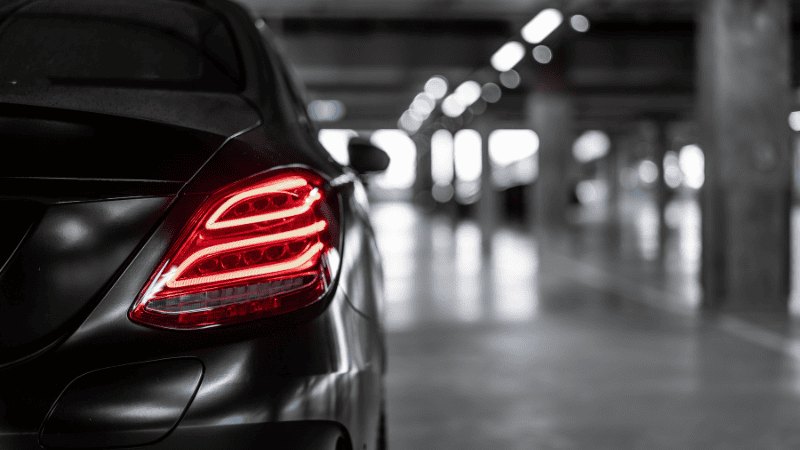
Some drivers may mistakenly use hazard driving lights in scenarios where they are not appropriate, leading to potential confusion or dangers on the road.
For example, it is not advisable to use hazard lights as an excuse for illegal parking, such as stopping quickly in a non-parking zone to dash into a store.
This can mislead other drivers and does not excuse the illegal action. Similarly, turning on hazard lights while driving in bad weather is counterproductive.
When needing to slow down to exit the highway, particularly in cases of car trouble, using hazard lights can also be problematic. It removes the ability to signal specific intentions like changing lanes or turning, making it difficult for other drivers to ascertain your next move.
7. Specialty Lights
Specialty lights, such as reverse lights and emergency vehicle lights, play unique roles in vehicle safety and communication.
Reverse lights illuminate brightly when a vehicle is put into reverse gear, signaling to other drivers and pedestrians that the vehicle is about to move backward.
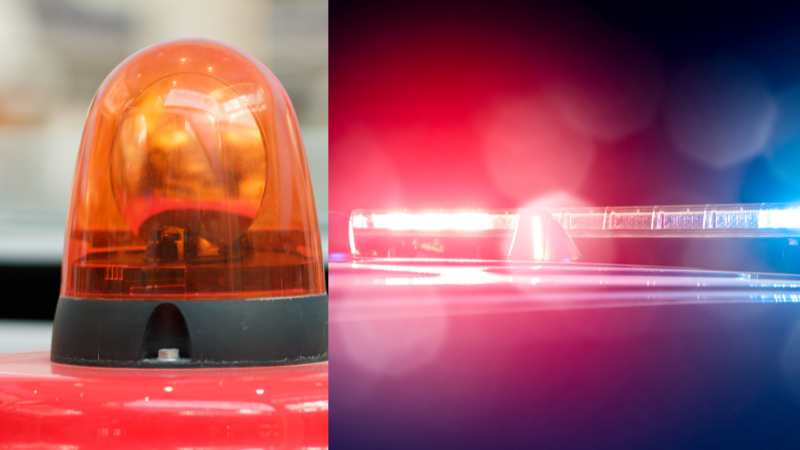
This function is crucial in parking situations or when repositioning a vehicle, as it alerts those around to maintain a safe distance or pause their movement. The clear, white light ensures high visibility, even in low-light conditions, enhancing safety during reversing maneuvers.
Emergency vehicle lights are designed to capture attention immediately. These lights vary in color—police vehicles often use blue and red lights, ambulances usually opt for red and white, and fire trucks are known for their red lights.
Each type of emergency light has a specific meaning, but all share the common purpose of signaling an urgent situation.
When drivers see these lights, they know to clear the way by moving over to the side of the road or stopping if necessary. This quick response is vital for emergency vehicles to reach their destination without delay.
Conclusion
So, there you have it—seven different types of car lights that play a significant role in vehicle safety and communication.
Each light serves a unique purpose in different scenarios, and understanding their functions is crucial for safe driving. Whether tail lights, signal lights, hazard lights, or specialty lights, they all work together to create a safer and more efficient driving experience.
Remember, Divers have to maintain these lights in working order and understand their correct usage as outlined by traffic laws and best practices.
Stay Bright, Stay Safe With LED Headlights at Carlightvision
Making your car safe and unique to you is important, especially when most of your time is spent driving. Carlightvision understands this need deeply, having dedicated ourselves since 2008 to manufacturing custom automotive headlights.
Our Guangzhou-based factory, sprawling over 8,000 sq m., can produce up to 1,000,000 pieces of lighting monthly, such as the 360 LED, Bi-LED, and D-Series LED, etc.
With Carlightvision, you’re not just choosing quality and affordability for your car’s lights; you’re getting an idea of how bright safety can be. Contact us now!
